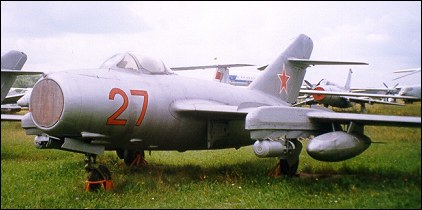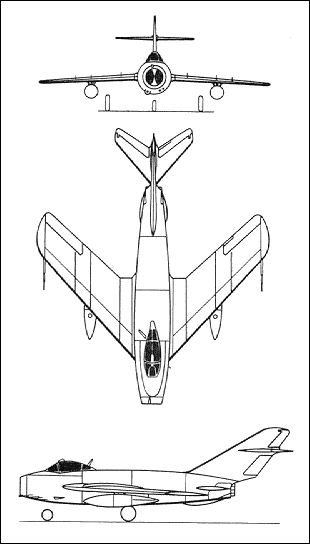|
| Less than a year after the MiG-15 had been sanctioned for production (1948), this design bureau initiated work on a follow-on fighter that would approach the speed of sound mainly through refinement of the basic airframe configuration. The first prototype received the designation I-330, and flew for the first time in January 1950. Claims that the I-330 managed to better M1.0 during test flights are believed to be unsubstantiated, but the overall improvements in performance were important.
Following the loss of the first prototype, a second and further improved prototype took over, allowing
testing to be completed in 1951, and production of the MiG-17 was given the go-ahead. Compared to the
MiG-15, the MiG-17 had a lengthened fuselage with softer taper, larger area tail surfaces to benefit handling
characteristics, and thinner section wings with rounded tips. Indeed, the wings were designed from scratch,
with the inner leading-edges extended forward; this resulted in greater root chord and varying leading-edge
sweepback (45° along inner portions, 42° on outer panels). A mark of identification was the MiG-17's three
boundary layer fences on each wing.
Production began with a day fighter model (NATO `Fresco-A'), which retained the VK-1 engine. The later MiG-17PF introduced all-weather capability, housing Izumrud S-band radar in a `bullet' radome at the
centre of the nose air intake and in an extension on the upper lip of the intake. Subsequently, this S-band radar was superseded by an E/F-band version of `Scan Fix', which still gave neither a large antenna nor a wide angle of scan and is now thought obsolescent.
In addition to the specialised two-seat trainer derivative of the MiG-17, known as the JJ-5 and exclusive
to Chinese production, the MiG-17 was also built (apart from in the former USSR) in China, Czechoslovakia and Poland, with whom it was known as the J-5, S-104 and LiM-5 respectively. A total of 11,015 was built (including licence production). The last one was built in 1958.

| CREW | 1 |
| ENGINE | 1 x turbo-jet VK-1F(N) |
| WEIGHTS |
| Take-off weight | 5200 kg | 11464 lb |
| DIMENSIONS |
| Wingspan | 9.6 m | 32 ft 6 in |
| Length | 11.4 m | 37 ft 5 in |
| Height | 3.8 m | 12 ft 6 in |
| Wing area | 22.6 m2 | 243.26 sq ft |
| PERFORMANCE |
| Max. speed | 1114 km/h | 692 mph |
| Ceiling | 15000 m | 49200 ft |
| Range | 2000 km | 1243 miles |
| ARMAMENT | 1 x 37mm machine-guns, 2 x 23mm machine-guns, bombs or missiles |
| lxbfYeaa, e-mail, 14.03.2024 06:31 20 reply | | George Gould, e-mail, 22.03.2020 01:18 My 1953 MiG 17 Fresco A came from Bulgaria. N75490 is a Fresco A has no afterburner on the Nene engine. AB came on the next airframes. Total loss pneumatic brake system. Burned about 130 gal /hr. Gave it to Evergreen Museum . You can see it in McMinville Oregon sittin next to the Spruce Goose. Check it out. reply | | Hassan Aljazaeri, e-mail, 29.07.2013 17:02 In 1973 war tens of Mig 17 air crafts were piloted by young Syrian pilots (16-17) years old and they were very effective in low flying missions against Israeli tanks . reply | | ?, 26.12.2011 15:48 Obviously.How about a plane flying 3500 miles per hour and a turning radius of 500m? reply | |
| | bombardier, e-mail, 26.05.2011 10:02 The MiG-17 clearly showed that speed isn't the most important in a dogfight.It shot down F-105,Phantoms and Mirages even though they were twice as fast reply | | Cpt. Fucko, e-mail, 15.08.2010 03:47 Wings Over Vietnam features this plane, as well as the MiG-19 and 21. Fun to fly for sure. reply | | Gary Eubanks, e-mail, 12.01.2010 09:22 From Russia to Reno to Hollywood with Love
Some years back a very clever pilot /weird air plane magician / business man found a bunch of MIG-17's behind The Wall and managed to have them shipped here "as is" along with tons of spare engines & parts. They showed up at port of entry fully armed. US Customs & ATF went ballistic. Stripped the planes down to the wing spars to haul away anything dangerous, then let them in.
CIA (Classics In Aviation) rebuilt them all to cherry condition. He even got TWO rare 2 seat trainers. Hollywood was dying for the real things as they used F-4's, A-4's, F-5's etc. as MIG substitutes in movies.(not very realistic)
Instrument panel makeover from Cyrillic to English and metric to standard was fun to watch.
Since Hollywood overdoes everything they just had to be painted in Director's version camoflage as opposed to bare skin to look racier on film.
They're not the fastest things around but they are QUICK! GLOC you out in a heartbeat! All the ones you saw used in movies and TV had to be flown like Cessna's so the camera planes and audience did'nt get lost. The egress systems were so Stone Age they were one step ahead of just jumping out, it takes a very good and nervy pilot even though they have very forgiving flight manners & reliability. We all know well how quick Murphy can show up on either end of an airstrip.
The man that made all this happen was killed riding as a passenger on a fire fighting plane crash /freak accident.
No idea where everything went after that, but the birds are still film stars-even if some of them undoubtedly shot down some of our stuff. You have to give the Russians due credit, this plane was WAY ahead of it's time. reply | | Swisher, e-mail, 07.01.2010 06:41 Yeah, this baby can perform; just ask Driscoll, or Cunningham, USN. reply | | alark, 13.08.2009 06:04 this plane has very nice performence I want FLY this plane reply | | HA Al-Jazaeri, e-mail, 29.07.2009 18:55 The Mig 17 was one of easiest aircraft to fly . reply | | Nathan Lowthorp, e-mail, 03.06.2008 23:33 Yes the MiG 17 is on of the earliest aircraft that has an afterburner. It is a single stage burner reply | | Clyde Young, e-mail, 20.05.2008 23:23 Did the Mig 17 have an afterburner? reply |
|
Do you have any comments?
|
| 
COMPANY
PROFILE
All the World's Rotorcraft
|








